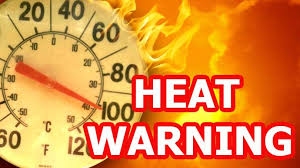
As summer temperatures soar across large parts of the United States, extreme heat warnings and heat advisories have been issued by the National Weather Service (NWS), alerting millions to the dangers of dangerously high temperatures. The heat wave sweeping across the country is not just uncomfortable — it’s potentially life-threatening.
Whether you live in the Midwest, South, or the West Coast, understanding the risks, recognizing the symptoms of heat-related illness, and taking preventive measures can help protect you and your family.
What Is a Heat Advisory or Extreme Heat Warning?
A Heat Advisory is issued when high temperatures and humidity levels combine to make it feel much hotter than it actually is — usually a “feels-like” temperature of 100°F (38°C) or higher. This level of heat can pose health risks, especially for vulnerable populations such as children, the elderly, and those with preexisting health conditions.
An Extreme Heat Warning (sometimes called an Excessive Heat Warning) is more serious. It signals that dangerously hot conditions are either occurring or imminent — typically with real or feels-like temperatures exceeding 105°F (40°C) for extended periods.
Both alerts are issued to urge the public to take action immediately to avoid heat-related health emergencies.
What Areas Are Being Affected?
In the past week, multiple states have been placed under heat alerts, including:
-
Texas and Arizona, where temperatures have soared above 110°F.
-
Parts of the Midwest, including Illinois, Missouri, and Kansas, experiencing both high heat and humidity.
-
California and the Pacific Northwest, where unusual heat levels are impacting regions not accustomed to extreme summer temperatures.
Urban areas face even higher risk due to the “urban heat island” effect — where buildings, roads, and other infrastructure retain more heat.
Why This Heat Wave Is Different
Meteorologists have noted that this year’s heat wave is more prolonged and widespread than usual. Climate scientists point to a combination of factors:
-
High-pressure ridges in the atmosphere are trapping hot air over parts of the U.S.
-
Drought conditions in the Southwest are worsening the intensity of the heat.
-
Climate change continues to drive more frequent and more intense heat waves globally.
These extreme conditions are not just a one-time event — they are part of a broader trend toward hotter, longer summers.
The Dangers of Extreme Heat
Extreme heat is one of the deadliest weather events in the United States, often underestimated because the symptoms of heat-related illness can appear slowly.
Here are some major health risks:
-
Heat Exhaustion:
Symptoms include heavy sweating, weakness, dizziness, nausea, headache, and fainting. If not treated, it can progress to heat stroke. -
Heat Stroke:
This is a medical emergency. Body temperature rises above 103°F, and symptoms may include confusion, rapid pulse, dry skin, and unconsciousness. Immediate medical attention is needed. -
Dehydration:
High temperatures increase the risk of fluid loss, especially if you’re outdoors or physically active. -
Respiratory Distress:
Poor air quality often accompanies heat waves, especially in urban areas, triggering asthma attacks and other breathing issues.
Who Is Most at Risk?
While extreme heat affects everyone, some groups are more vulnerable:
-
Infants and young children: Their bodies don’t regulate temperature as well.
-
Elderly adults: Often have chronic conditions and are less sensitive to thirst.
-
Outdoor workers: Construction workers, landscapers, and delivery drivers are exposed for long periods.
-
Athletes: Those training in the heat can easily become dehydrated.
-
People with chronic illnesses: Heart disease, diabetes, and obesity increase heat sensitivity.
-
Low-income households: May not have access to air conditioning or cooling centers.
How to Stay Safe During a Heat Wave
Here are practical tips to protect yourself and others during a heat advisory or warning:
1. Stay Hydrated
-
Drink plenty of water even if you don’t feel thirsty.
-
Avoid alcohol, caffeine, and sugary drinks, which can dehydrate you.
2. Limit Outdoor Activity
-
Avoid strenuous activity during peak heat (usually 10 a.m. to 4 p.m.).
-
Reschedule exercise routines for early morning or evening hours.
3. Use Air Conditioning
-
Stay indoors in air-conditioned spaces whenever possible.
-
If you don’t have AC, go to a mall, library, or designated cooling center.
4. Dress for the Weather
-
Wear lightweight, light-colored, loose-fitting clothing.
-
Protect your skin with sunscreen and wear a wide-brimmed hat.
5. Check on Vulnerable Neighbors
-
Reach out to elderly friends, family, or neighbors to make sure they’re safe.
-
Offer to help those without access to cool shelter or transportation.
6. Never Leave Children or Pets in Cars
-
Temperatures inside a parked car can climb to deadly levels in minutes.
How Cities Are Responding
Many cities across the U.S. have opened cooling centers, extended public pool hours, and deployed emergency resources to prevent heat-related deaths. In some areas, electricity demand is peaking as residents rely heavily on air conditioning, prompting energy conservation advisories.
Some states have issued worker safety regulations requiring mandatory breaks and hydration access for outdoor workers during extreme heat events.
What to Do If You Feel Sick
If you or someone else is experiencing symptoms of heat exhaustion or stroke:
-
Move to a cooler place immediately.
-
Drink water or an electrolyte solution.
-
Apply cool, damp cloths to skin or take a cool shower.
-
Call emergency services if symptoms worsen or include confusion, loss of consciousness, or a high body temperature.
Long-Term Outlook and Climate Impact
The current heat wave is not an isolated event — it’s part of a growing trend. Over the past decade, the U.S. has seen an increase in both the frequency and severity of heat waves, a pattern consistent with global climate change projections.
Experts urge better infrastructure planning, public education, and long-term policies to deal with these recurring extreme weather events. This includes planting more trees, improving building design for better cooling, and investing in emergency preparedness.
Final Thoughts
Extreme heat isn’t just uncomfortable — it’s dangerous and, at times, deadly. With heat advisories and extreme heat warnings being issued more frequently, now is the time to take proactive steps to stay safe and help others.
Whether you’re dealing with record-breaking temperatures in the Southwest or high humidity in the Midwest, staying informed and prepared is key. Follow official weather updates, practice heat safety, and spread awareness to protect your community.










